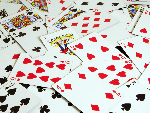 It's time for some magic!
It's time for some magic!
Don't worry, there's no complicated sleight-of-hand in these tricks. Not only does math make them easy, but you don't even have to do any math during the routines, since all the math involved has been worked out ahead of time.
I'll start with the simpler of the tricks. In this first one, you have someone think of any hour of the day, and you tap numbers on an analog watch while they silently count up to 20. When they reach 20, they say “Stop!”, and your finger is on the hour they secretly chose!
The method behind this simple trick is described in Futility Closet's On Time post.
At first, the workings may confuse you, but a little experimentation with different numbers will help you understand it. Obviously, this is also true for anyone for whom you perform it, so don't treat this as a big mystery, but rather as a simple and interesting experience.
The basic tapping presentation has a long history in magic. In Martin Gardner's book, Mathematics, Magic and Mystery, there's an entire section on tapping tricks. Thank to Google Books, you can read the entire section online for free, running from page 101 to page 107.
The next trick, courtesy of Card Colm, is a little more involved. You have someone name any card suit, have a regular deck of cards shuffled, and then the number cards (Ace through 9) are removed in the order in which they're found in the deck. You then make an unusual bet based on divisibility of various numbers formed by those cards.
This trick is called the $36 Gamble, and the method is found in Card Colm's post, The Sequence I Desire. Magic: When Divided, No Remainder. Beyond just the mathematical method, there's plenty to explore under the hood of this routine, including Arthur Benjamin's method for determining divisibility by 7, and a very deceptive shuffling method, which appears fair.
If you enjoy the deceptive shuffles discussed in the above post and its links, you also might enjoy Lew Brooks' book Stack Attack, which features the False False Shuffle. The false shuffle and the routines in Stack Attack mix well with the principles behind the $36 Gamble. In my 2006 review of the DVD of the same name by the same author, you can get a better idea of the contents.
Even though I've only linked to 2 tricks here, practicing them, understanding them, and digging in to the variations I've mentioned is more than enough to get your mental gears turning, so have fun exploring them!
0
Numerous Wonders
Published on Monday, November 04, 2013 in books, downloads, fun, magic, Martin Gardner, math, money, playing cards, products, site features
Related Posts
Post Details
Posted by Pi Guy on Nov 4, 2013
Labels:
books,
downloads,
fun,
magic,
Martin Gardner,
math,
money,
playing cards,
products,
site features
Subscribe to:
Post Comments (Atom)




No Response to "Numerous Wonders"
Post a Comment